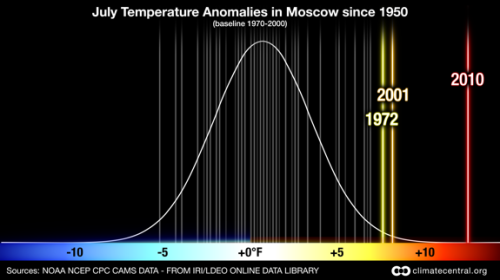A major new study has reanalyzed the connection between global warming and the record-breaking temperatures we’ve been seeing. Stefan Rahmstorf and Dim Coumou conclude in their PNAS paper, “Increase of extreme events in a warming world“:
… the majority of monthly records like the Moscow heat wave must be considered due to the warming trend. In highly aggregated data with small variability compared to the trend, like the global-mean temperature, almost all recent records are due to climate warming.
Basically, they show that when there is a lot of variability in temperature, as there is on in individual days, finding a trend in extreme records at any single location thanks to global warming is small: “daily data from a single weather station may not yet show a major change in temperature extremes due to global warming.”
But when you look at the monthly and especially yearly temperature data at a location, data that have considerable less fluctuation, then a warming trend is far more likely to create a new record. And as lead author Rahmstorf explained to me, this matters because “monthly temperature records have much more impact on human society” in terms of impact on human health, mortality, and crop failures.
And, of course, the Russia’s heat wave did kill 700 people and cause them to ban grain exports for over a year after their crops shriveled (see Russian President Medvedev: “What is happening now in our central regions is evidence of this global climate change, because we have never in our history faced such weather conditions in the past”).
The PNAS study found:
For July temperature in Moscow, we estimate that the local warming trend has increased the number of records expected in the past decade fivefold, which implies an approximate 80% probability that the 2010 July heat record would not have occurred without climate warming.
Global warming increased the chance of this monster heat-wave occurring by a factor of 5. I’d note that Tamino doing a far cruder analysis had estimated global warming had increased its chances by a factor of 8.
This is only a bombshell because NOAA did a flawed analysis just a few months ago that found no connection between global warming and the record-smashing. Back in March, NCAR Senior Scientist Kevin Trenberth challenged NOAA’s attribution analysis, “Many statements are not justified and are actually irresponsible,” as Climate Progress reported. It is unusual for a major study like that to be essentially refuted in such a short time in the peer-reviewed literature.
I asked Rahmstorf what NOAA did wrong, and he said it was “bad data treatment.” He told Wired that the NOAA study showed “an absence of evidence, not evidence of absence. We found the evidence.” Here is one key figure:
NOAA had claimed there was no trend in the relevant temperature data, but in fact there clearly was. They wrote, “We conclude that the intense 2010 Russian heat wave was mainly due to natural internal atmospheric variability,” but that now clearly appears to be wrong, much as Trenberth had suggested.
The PNAS study concludes:
Our statistical method does not consider the causes of climatic trends, but given the strong evidence that most of the warming of the past fifty years is anthropogenic, most of the recent extremes in monthly or annual temperature data would probably not have occurred without human influence on climate.
Of course, the reason why people are concerned about global warming is because of what we face if we don’t restrict greenhouse gas emissions. There the original NOAA study still carries a powerful warning: “Monster crop-destroying Russian heat wave to be once-in-a-decade event by 2060s (or sooner).”
Again, this extreme event ended Russian grain exports for year. So the increase in extremes very much threatens food security if we don’t act soon to reverse emissions trends.
I had very interesting conversation with Rahmstorf about the metaphor of loading the dice for extreme weather events and whether or not we are painting higher numbers on the dice, but I’ll discuss that in a few days.
This is a cautionary tale: One needs to do these statistical “attribution” studies very carefully to fully understand how much to attribute the impact of the human-caused warming trend on extreme events.









No comments:
Post a Comment